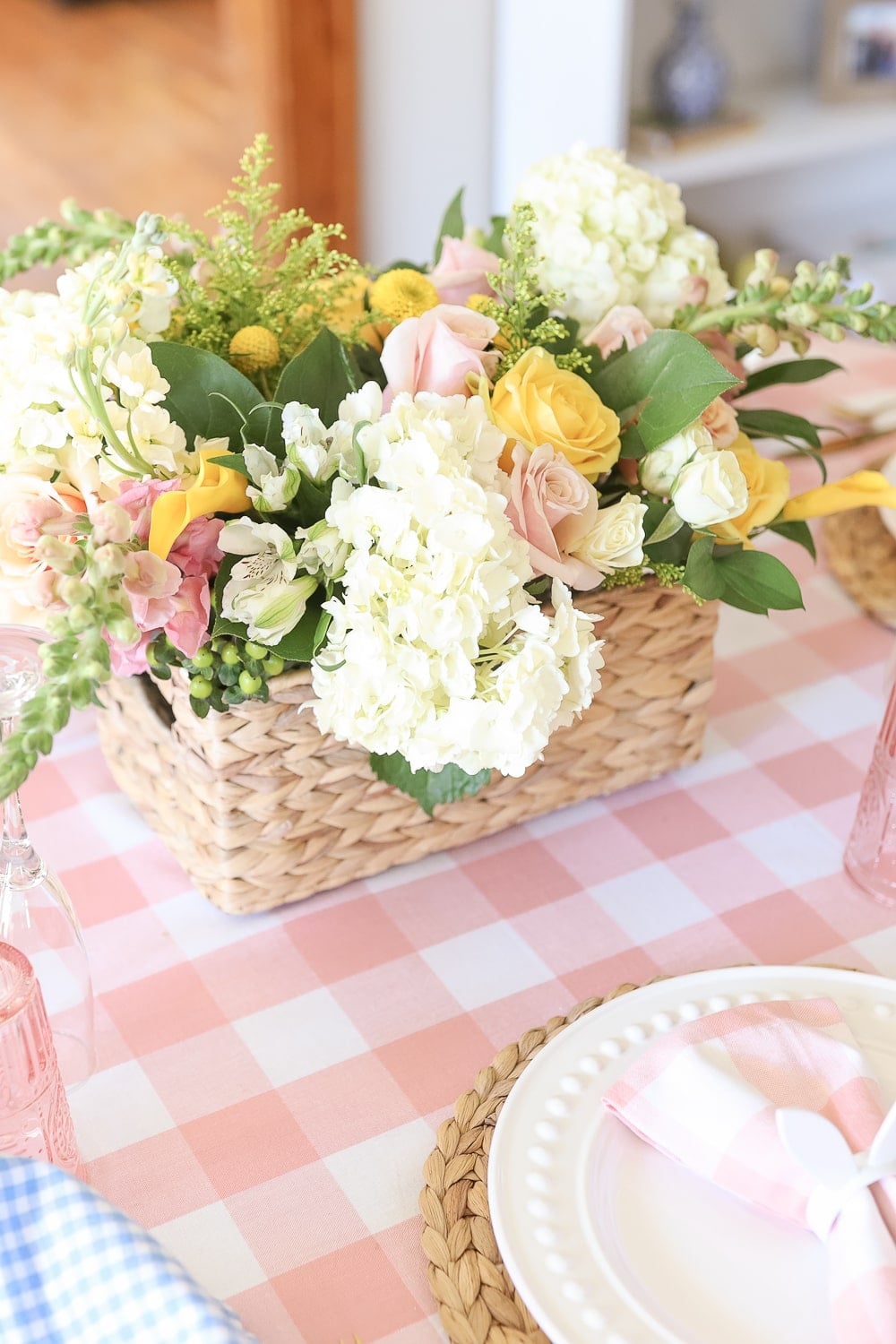*This post may contain affiliate links, which means I may receive a commission (at no additional cost to you!) if you make a purchase using any of these links.*
I stumbled upon Full Bloom on HBO Max one afternoon and reluctantly decided to give it a go. I’ve purchased about a dozen floristry books over the past few years, so I already knew the basics for how to arrange grocery store flowers– cut your stems at a 45-degree angle, change the water frequently, remove all leaves below the waterline to prevent excess bacteria. I really wasn’t hopeful that I’d learn anything new or even be able to get into the series. Y’all, I was so wrong! I killed the entire series in one afternoon! I was so inspired by the contestants that I went and grabbed a bunch of grocery store flowers from Hy-Vee and created one of my favorite self-designed arrangements of all time. It’s actually the Easter arrangement in the photo above (see the whole tablescape here)!
If you’re an aspiring floral designer, whether you hope to do it professionally or for fun, you’ve got to give Full Bloom a watch. It’ll just give you that creative and mechanical boost you need to take your flower arrangements (especially your grocery store flower arrangements) to the next level. That said, whether you want to know how to arrange grocery store flowers or you want to do something more advanced, like design your own floral wedding arch, I found that the show is helpful for both large and small-scale projects. Keep reading for the top ten floral tips I got from HBO’s Full Bloom—
Top Ten Floral Tips from HBO’s Full Bloom
1. Chicken wire is incredibly handy.
More often than not, the contestants on Full Bloom used chicken wire as their base. Chicken wire. Not only is it ultra budget-friendly, but it’s also robust and can be molded in a million different shapes. Whether you just clump some up and put it in a vase or you use it to create something grander, like a floral chandelier or wedding arbor, chicken wire is a must-have mechanic for floral designers.
2. Portion out your flower food.
I’m totally guilty of dumping an entire packet of flower food in a vase and then not even letting it dissolve. What you’re supposed to do, though, is use a quarter of your flower food at a time. You should also change the water and add new flower food every single day!
3. Reflexing flowers can transform an arrangement.
I had no idea reflexing flower petals was a thing– but it is, and it’s one of the top tips for how to arrange grocery store flowers like a pro! Reflexing, which is essentially gently pushing on the backs of rose, orchid, or tulip petals to invert them, forces flowers to open up and bloom. It can seriously transform tightly-furled roses into voluminous blooms in seconds!
4. Floral spray paint exists.
I always thought colored flowers were created by messing with soil acidity. That may still be true, but you can also dye them with floral spray paint. Whether you’re trying to create a unique color palette or you want to enhance the natural color of your flowers, it’s a way to completely transform your arrangement– and it’s gentle enough for even the most delicate blooms. If you want to test out floral spray paint for yourself, professional florists use this brand. Their products come in a wide range of colors and can be found on Amazon!
Quick note– I’ll admit that I was curious myself, but please do not try and use regular spray paint. It’s toxic to both flowers and plants.
5. Droopy hydrangeas can be revived overnight.
I’ve heard the droopy hydrangea tip before, but I didn’t realize I was doing it wrong. I thought you were supposed to dunk a hydrangea in some water really quick and then put it back in the vase. Turns out, no. What you’re actually supposed to do is completely submerge the hydrangea flower in a bucket of water and let it sit for five minutes. Next, shake it out, let it dry, and give it a fresh cut. It’ll perk back up within a few hours, depending on how wet it is!
6. You can preserve flowers by misting them with water.
If you’re arranging your own wedding flowers or working on a larger-scale floral project, you can keep your flowers hydrated by misting them with water. Flowers actually soak up the spritzed water drops, so misting them a few times a day can help keep them looking fresh– even for days at a time!
7. Tulips blossom in lukewarm water.
More often than not, when you buy tulips, their buds are closed… and it’s intentional. Tulips are typically kept in cold water or in a refrigerator to help preserve the life of the flowers until they’re purchased. So, if you have a bunch of tulips that need to bloom, let them sit in lukewarm water. It’ll help to activate the tulip’s petals so that they open up faster. What you’re essentially doing is tricking the tulips into blooming early indoors, and it works like an absolute charm!
8. Mouthwash helps keep your flowers alive longer.
Not only does antiseptic mouthwash mask the odor of smelly flowers (like Limonium), it helps keep flowers alive longer. The theory, which holds water (pun intended), is that mouthwash kills bacteria in the water like it kills plaque. This home remedy requires a capful of mouthwash per quart of water, and it’s pretty genius. Other popular strategies for keeping flowers alive longer involve dropping an aspirin tablet or copper penny in the water, adding in a few drops of bleach, and mixing one part 7-Up (or any other citrus soda) with three parts water.
9. Certain flowers are hardier than others.
As much as I love delphiniums and sweet peas, they’re both super delicate and sensitive to temperature. Roses, on the other hand, are hardy as all get-out. So are mums, carnations, daisies, anthurium, orchids, calla lilies, alstroemeria, baby’s breath, freesia, and gladiolus. Not only are they able to tolerate more extreme weather conditions, they’re easy to arrange and last the longest after being cut.
Flowers that aren’t quite so resilient? Poppies, lilies, gardenias, and dahlias, among others. A lot of florists would throw peonies and ranunculus (two of my personal favorites) into the mix, as well. As beautiful as they are, they bruise easily and are prone to wilting. That’s not to say you shouldn’t use them in your floral arrangements– just be aware that they won’t last long.
10. Flowers tell a story.
I would’ve never thought that you could tell a heartfelt story with flowers, but the Full Bloom contestants proved me wrong. Every single arrangement, tablescape, and bouquet had its own unique narrative. My personal favorite was Kristen’s suspended arrangement. She “boned” some leaves to create a ribcage and then had orchids pouring out of it to represent the feeling you get when you get a hug. It was spot on, ultra-creative, and downright magical.
Other incredible pieces worth checking out are Beth’s medieval tablescape (and pretty much all of Beth’s individual designs) and Connor’s grocery store arrangement (and also pretty much all of Connor’s individual designs, too). Oh, and Team Beth’s “Gates of Hell” design was insane.
In case you can’t tell, I’m literally crossing my fingers that HBO releases a second season. Full Bloom gives so many practical tips for how to arrange grocery store flowers, and it’s a must-watch for amateur florists like me. If you’ve watched the first season, what did you think? Were you as into it as I was? Also, if you have any recommendations for other florist competition shows, I’d love to hear them! I’ll be honest– I tried The Big Flower Fight on Netflix and wasn’t a fan. Too much drama and not enough flowers!
PS- For more Easter flower arrangement inspiration, check out last year’s simple Easter tablescape! I found the most gorgeous pink and white tulips, and they tie the whole thing together so nicely.





Love your handy tips!
This is wonderful information.
I always buy flowers, but now I’ll know how to make them last!
http://a-woman-of-a-certain-age.com/